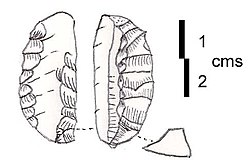
Orange slice is an early sickle blade element made out of flint. The flints are so called due to their shape, which resembles a segment of an Orange. The morphology was first recognized by J. Hamal-Nandrin and J. Servais in 1928, who called them "Quartier d'orange" in French. This sickle industry has no evidence of developed denticulation. Orange slices were used for harvesting plants at the start of the Neolithic Revolution and were particularly prevalent in Lebanon where they were found alongside Heavy Neolithic axes and larger flint tools of the Qaraoun culture in and around Qaraoun in the south of the country. Sites where orange slices have been found include Mejdel Anjar I, Dakwe I and II, Habarjer III, Qaraoun I and II, Kefraya, and Beıdar Chamout. Orange slices were only found in large quantities around Qaraoun, where it is suggested they were part of a specialist Neolithic industry of the area.
References
- Moore, A.M.T. (1978). The Neolithic of the Levant. Oxford University, Unpublished Ph.D. Thesis. p. 443.
- Hamal-Nandrin J. & Servais, J., Instruments à section triangulaire ou quadrangulaire et dont une ou deux faces sont retouchés, Bulletin de la Société Préhistorique Française 25, pp. 505-517, 1928.
- Lorraine Copeland; P. Wescombe (1965). Inventory of Stone-Age sites in Lebanon, p. 145. Imprimerie Catholique. Retrieved 21 July 2011.
- L. Hajar, M. Haı¨dar-Boustani, C. Khater, R. Cheddadi., Environmental changes in Lebanon during the Holocene: Man vs. climate impacts, Journal of Arid Environments xxx, 1–10, 2009.
- E. J. Peltenburg; Alexander Wasse; Council for British Research in the Levant (2004). Maya Haïdar Boustani, Flint workshops of the Southern Beqa' valley (Lebanon): preliminary results from Qar'oun* in Neolithic revolution: new perspectives on southwest Asia in light of recent discoveries on Cyprus. Oxbow Books. ISBN 978-1-84217-132-5. Retrieved 18 January 2012.